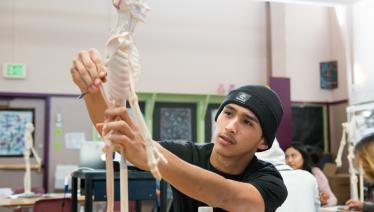This article helps educators understand the role that academic language plays in their classrooms and in ELL student success.
The article also includes information on social vs. academic language, as well as numerous examples of the different kinds of academic language needed for all students to fully participate in classroom activities and assignments. Additional articles, books, and videos can be found in our Academic Language and ELLs Resource Section.
Academic Language: An Overview
Why is academic language important?
Perhaps you or your colleagues have taught a student, who, like Carlos, gave every sign of being fully "fluent" in English, only to find that the student struggled on more academic kinds of assignments.
Many students, including English language learners (ELLs), have difficulty mastering the kinds of academic language needed to succeed in school, especially if they have never been explicitly taught how to use it. These students include long-term ELLs, students who have attended U.S. schools for much or all of their education but have not yet mastered the language of school.
At the same time, many educators have never learned how to teach academic language since language has traditionally been considered the domain of English as a Second Language (ESL) or English language arts teachers. Yet the use of academic language is more important than ever in preparing students for academic and professional success, particularly in the era of rigorous college- and career-ready standards (such as the Common Core State Standards) that require an increased use of academic language in and across all disciplines.
What is your role?
It may seem daunting at first, but you have an important role to play in supporting your students' academic language development. You do not need an in-depth background in linguistics or ESL methods to do so; rather, you need some guidance and practice in learning how to recognize the role academic language plays in your subject area and classroom, as well as support from colleagues who can guide you in your efforts. Many ESL and bilingual colleagues have extensive experience in identifying students' academic language needs and collaborating with colleagues and will be more than happy to do so if asked!
In this article
To get you started, this article shares three things you need to know about academic language:
- The difference between social and academic language
- The importance of looking beyond vocabulary
- How academic language will be used in your classroom
The article will also share recommended resources for further review. For specific instructional strategies on increasing the use of academic language in your classroom, see these ideas from ELL expert Kristina Robertson, as well as the resources at the end of the article, and check in with your ESL/bilingual colleagues for additional suggestions!
The difference between social and academic language
As the example of Carlos above suggests, teachers may be most familiar with the level of students' social language — the language they hear students using with their friends in the hallways or on the playground. Students typically achieve proficiency in social language long before they have mastered a grade-appropriate level of academic language. As a result, a student's ability to use language in social settings is not necessarily an accurate indicator of their mastery of academic language.
What is academic language?
Academic language is the language of school and it is used in textbooks, essays, assignments, class presentations, and assessments. Academic language is used at all grade levels, although its frequency increases as students get older.
It is also the language of the workplace — for example, the language used to write a business letter as opposed to a casual e-mail to a co-worker.
Examples
One strategy that academic language expert Dr. Robin Scarcella uses to help her college students understand the difference between social and academic language is to provide them with similar sentences or passages that convey the same meaning but that are written in different styles, such as the following:
Social English | Academic English |
I like this book more. | This story is more exciting than the first one we read. |
It worked. | Our experiment was successful. |
Because they were brave. | The soldiers received the medal because of their courage. |
If you were to compare other kinds of passages or documents, some examples might include:
- A business letter vs. a personal e-mail (noted above)
- A newspaper's summary of a research report vs. the actual abstract of the report
- A customer review of a book vs. the publisher's description of the book
As your students become more familiar with the differences between social and academic language, it will be easier to identify which is which and what is most appropriate for a certain setting. Kristina Roberston notes in her video clip on our academic language playlist that her students call this "sounding smart" — and they know it when they hear it. When they hear themselves "sounding smart," it is a source of excitement and motivation in the classroom.
Additional resources
To learn more about the distinctions between social and academic language, take a look at the following resources from Colorín Colorado:
- What is the difference between social and academic language?
- Video: Social vs. academic language (Dr. Cindy Lundgren)
- Webcast: Academic Language and ELLs, featuring Dr. Scarcella
- Academic Language webcast powerpoint
Discussion questions:
- Have you had any students who were proficient in social language but struggled with academic language?
- If so, how did their social and academic language use differ?
- Did anything in their language abilities surprise you?
- What are some examples that could be used to compare social and academic language in your classroom?
Beyond vocabulary
Many people think of vocabulary first when it comes to academic language. While content-area vocabulary words and terms are certainly an important component, academic language also refers to the words and phrases used to connect these key words and to communicate concepts. Here are two different ways to understand a broader interpretation of academic language.
"Bricks and mortar"
Dr. Cindy Lundgren explains the idea of "bricks and mortar" in our academic language video playlist, where "bricks" are the key vocabulary words and concepts in a sentence, and "mortar" is the language (such as signal words and phrases) holding the bricks together. Here is the example she explains in the video:
Even though bats have wings, they are not birds.
In this sentence, the bricks are the key vocabulary words in bold:
Even though bats have wings, they are not birds.
Yet to fully understand the sentence, students must understand the meaning of "even though." Here is a sample definition:
"Even though" means that two items are similar, but they are not the same. In this case, bats and birds both share a similar feature (having wings), but they are not the same animal.
Understanding signal words and phrases is a key step in a student's ability to "unlock" the academic language they encounter, as well as to start using it correctly themselves.
Video: Bricks and mortar in language instruction
Dr. Cindy Lundgren discusses the concept of "bricks and mortar" when thinking about effective vocabulary instruction for ELLs.
TWIPs
Debbie Zacarian and Judie Haynes (2010) also look beyond discrete vocabulary words in their academic language definition, including a range of structures they call TWIPs (Terms, Words, Idioms, and Phrases). Here are some examples:
Terms | The boiling point of water is 212° F. |
Words | The Declaration is now on display in Washington, DC. |
Idioms | She came to town once in a blue moon. |
Phrases | Based on the data, we agree with the scientists' conclusion. |
Note that, in the second example, the "Declaration" is a single word standing in for the official name of a specific document (the Declaration of Independence). Many textbooks used abbreviated terms in the interest of space, which requires students not only to track the references back to the original term but to build on existing background knowledge about the subject being discussesd. ELLs may need some extra preparation to draw upon or build background knowledge in order to fully understand the academic language being used.
Same Word, Different Meaning
Keep in mind that some key words or terms may have different meanings across disciplines and may be used as different parts of speech in different contexts (i.e., noun vs. verbs):
Word | Meaning/Use |
Table | Lunch table (Social language) |
Plot | Plot of a story (ELA) |
Branch | Branch of government (Social Studies) |
Foot | Your foot (Health) |
As you identify the academic language you will be focusing on in a particular lesson, take a moment to think about whether any of the words or phrases may have another definition so that you can anticipate any possible confusion. You may wish to share your list with your ESL colleagues for input as well.
Cognates
Finally, there is a great tool you can use to bolster academic language for students who speak a language related to English. This is the use of cognates — words that have a similar spelling and meaning in both languages. More than a one third of words in English have a Spanish-language cognate! These often include technical or content-specific words that can help students make a connection between both languages, such as the following:
- institution – institución
- dinosaur – dinosaurio
- catastrophe – catástrofe
- biology – biología
- equilateral triangle – triángulo equilátero
- ceramic – cerámica
- artist – artista
You can see many more in our list of Spanish-English cognates, and your ESL or bilingual colleagues may be able to think of other related examples as well. Once students know how that a connection exists, they will start noticing more words that are related and they will be able to apply their own existing background knowledge about those words to the vocabulary they encounter. They may need some guidance initially, and we provide some tips on how to use cognates in this Colorín Colorado article to help you get started.
Note: There is such a thing as a false cognate, the most famous one being that embarazada in Spanish is not "embarrassed" — it means "pregnant"! It is not a 100% foolproof strategy — but it is generally a very useful tool.
Discussion questions:
- What are examples of key vocabulary words, terms, idioms, and phrases that are useful to know in your subject area?
- Can you think of some phrases or signal words that are not content specific but are commonly used in your area (such as "In comparison…")?
- Looking at the list of cognates from Colorín Colorado, find 10 words related to your subject area.
Planning for purpose and products
Now that you have some more background on what academic language is, it's time to think about how it is used in your subject area. Academic language is used for a variety of purposes across disciplines:
- Students may write a lab report in science class.
- Students may orally explain their reasoning in math class.
- Students may listen to and compare two famous speeches in history class.
- Students may compare a scene from a novel and a movie in an English language arts class.
Domains of language
As you can see in these examples, academic language is used in all four domains of language (reading, writing, speaking, and listening), and all four domains are needed to achieve the above tasks. While the uses of academic language may be more obvious for reading and writing, academic language is also necessary for listening to class discussion, lectures, and debates, as well as delivering speeches, presentations, and oral arguments. Students may need just as much help using academic language in their speaking as in their writing, and they may be at different levels across different domains. Carlos, for example, has strong academic listening and speaking skills, but weaker writing skills.
Students may also need help moving from the word level to the sentence, paragraph, or essay/project level in these sophisticated assignments. The most important thing you can do is to provide examples and model the kinds of language you expect students to use on a regular basis. By doing so, you will help familiarize students with the kinds of academic language needed to succeed in your classroom, as well as the purpose of the language they are using. Our Academic Language booklist and webcast include a number of subject-specific strategies for helping students master the kinds of language needed in different content areas.
This is also another area where ESL/bilingual colleagues can help you; they may have tried and true strategies, graphic organizers, and suggestions for modeling academic language and for helping students transition into more sophisticated assignments. One great example is the process that high school ESL teacher Michelle Lawrence uses to help her students transition from sentences and paragraphs to essays. (See Playlist: Writing Process 2.)
Note: Another helpful tool for communicating expectations about academic language is the use of language objectives , which you can learn more about from Colorín Colorado.
Discussion Questions:
- As you consider how academic language is used in your discipline, what kinds of assignments are students expected to produce in your classroom and in higher grades?
- What are some examples of academic language that are needed for each of these activities?
- How are different language domains used at different steps of the process? (For example, a lab may require spoken language to be used in discussions between partners, and then writing to be used for the final written lab report.)
- Based on what you now know about academic language, what kinds of support do you think Carlos needs in his chemistry class?
- Do you have any ideas on how Mrs. Wilson can support his written academic language?
Closing Thoughts
While it will take some practice to determine what kinds of academic language your students need to learn and how to help them master it, as they become more comfortable, you will see their confidence and output increase. Together, you'll start discovering new ways that academic language unlocks the doors to their success — and you'll wonder how you ever got along without it!
Special thanks to Dr. Karen Ford, Dr. Diane Staehr Fenner, Dr. Cindy Lungren, and Dr. Ayanna Cooper for their contributions to this article.
Recommended Resources
- Colorín Colorado: Academic Language Resource Section
- Colorín Colorado: Oral Language Development for ELLs
- Colorín Colorado: Reading and Writing with ELLs
- Colorín Colorado: Content-Area Instruction for ELLs
- Becoming an Academic Language Mentor for ELLs
- Education Week: Common Core Ratchets Up Language Demands for English-Learners


